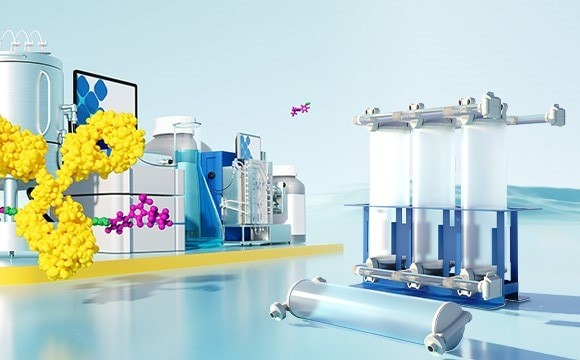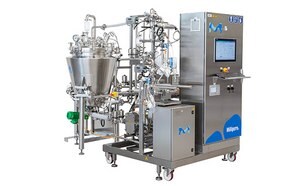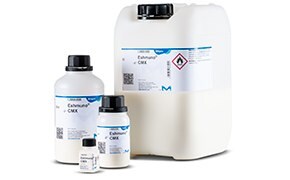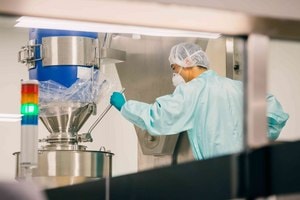Antibody Drug Conjugate Manufacturing: Purification

A bioconjugate is a complex of two molecules, at least one of which is a biomolecule. Bioconjugates offer incredible promise as a growing class of innovative targeted therapeutics. Antibody drug conjugates (ADCs) are a type of bioconjugate that use monoclonal antibodies (mAbs) to deliver highly potent active pharmaceutical ingredients (APIs) to target cells. ADCs comprise a monoclonal antibody (mAb) conjugated to a cytotoxic payload via a stable linker. Any ADC manufacturing strategy must consider both product quality and containment of potent APIs throughout manufacturing to maintain operator safety.
Bioconjugate purification and ADC purification must effectively remove impurities including high molecular weight species such as aggregates and undesired low and high drug-antibody ratio (DAR) species, as well as low molecular weight contaminants such as the API, residual payload, and solvents. At the same time, the process must be able to concentrate the ADC and maximize recovery without precipitating hydrophobic ADCs
Featured Categories
Our tangential flow (crossflow) filtration systems are engineered for low hold-up volume, maximum volume concentration, and optimal product recovery in single-use and multi-use applications from process development to large-scale manufacturing, with compatible holders available for expendables.
Ion exchange (IEX) chromatography separates biomolecules based on difference in charge between the target molecule and chromatography resin. Widely used in bioprocessing, our anion and cation exchange chromatography resins efficiently purify mAbs, recombinant proteins, vaccines, plasma, and other therapeutic molecules.
Simplify raw material needs with our versatile downstream chemicals. Optimal quality, support, and documentation for regulatory compliance.
Raman spectroscopy is among the many tools used in PAT implementation. This technique can be used to monitor cell culture CPPs such as glucose, lactate, cell density, and ammonium, as well as CQAs such as protein titer, glycosylation, and aggregation.
Considerations for an Antibody Drug Conjugate Purification Process
ADCs are purified using various technologies including ion exchange chromatography (IEX), and tangential flow filtration (TFF). Single-use technologies (SUTs) are increasingly utilized in ADC purification as they reduce the risk of cross-contamination, minimize cleaning requirements, and enhance flexibility in manufacturing processes.
DAR Variant Removal
The ADC chemical bioconjugation step yields a heterogeneous mixture of ADC species with variable DARs. The DAR is a critical quality attribute of the ADC molecule as it correlates with the potency of the therapeutic. Consequently, product related impurities, including high and low DAR species, must be removed to achieve purity targets.
Solvent Clearance
The ADC conjugation step is performed in the presence of an organic solvent such as dimethyl sulfoxide (DMSO) or dimethylacetamide (DMAc). These solvents must be removed during downstream purification.
Chemical Compatibility
To effectively purify the conjugated ADC process fluid, all fluid paths and purification technologies must be physically compatible with the organic solvents used in the conjugation step. In addition, extractables levels should be low to avoid potential patient safety concerns.
Operator Safety
Highly potent toxic linkers, payloads and organic solvents require special consideration for safe handling and containment during ADC conjugation and downstream workflows.
Solutions for Efficient and Safe Antibody Drug Conjugate Purification
Our solutions tackle the unique purification challenges of ADCs:
- Single-use technologies, like Mobius® systems, improve safety, efficiency and flexibility in production environments, and show excellent compatibility with commonly used solvents.
- Tangential Flow Filtration (TFF) with Pellicon® Capsules, offer a closed, disposable flow path for ADC purification, boosting throughput while maximizing operator safety.
- Mixed-Mode Cation Exchange Chromatography, specifically Eshmuno® CMX, effectively separates ADC variants while maintaining high selectivity and flow rates.
- The ProCellics™ Raman Analyzer measures solvent clearance and enables real-time process monitoring.
Visit our document search for data sheets, certificates and technical documentation.
Related Articles
- Find best practices for using Pellicon® Capsules in ADC processing as well as data from two studies using Pellicon® Capsules and Pellicon® cassettes in the ADC manufacturing process.
- Before adoption of single-use technologies in biomanufacturing, manufacturers must assess the risk to the drug product from potential leachables. This article highlights a general approach based on the United States Pharmacopeia (USP).
- Take advantage of strength and leak prevention in containers made from Ultimus® film. Leak free transportation in single-use bioprocessing bags.
- ADC payload intermediates such as, DOLCore ™, MAYCore ™, and PBDCore ™, simplify payload synthesis for the most commonly used payloads: maytansine, dolastatin, and PBD dimers.
- Use of Eshmuno® CMX mixed-mode resin presents a significant opportunity to streamline ADC purification, improving process robustness and scalability.
- See All (4)
Find More Articles and Protocols
How Can We Help
In case of any questions, please submit a customer support request
or talk to our customer service team:
Email custserv@sial.com
or call +1 (800) 244-1173
Additional Support
- Chromatogram Search
Use the Chromatogram Search to identify unknown compounds in your sample.
- Calculators & Apps
Web Toolbox - science research tools and resources for analytical chemistry, life science, chemical synthesis and materials science.
- Customer Support Request
Customer support including help with orders, products, accounts, and website technical issues.
- FAQ
Explore our Frequently Asked Questions for answers to commonly asked questions about our products and services.
To continue reading please sign in or create an account.
Don't Have An Account?




